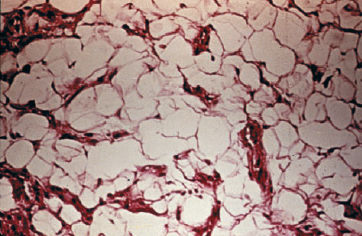85
Lipoma
Kevin D. Plancher and Michael Bothwell
History and Clinical Presentation
A 40-year-old right hand dominant woman presents with a mass on her right little finger. The mass has grown in size and is now causing functional problems. The patient reports the mass is not painful. She also reports a recent weight gain, corresponding with the enlargement of the mass.
Physical Examination
The patient has full range of motion of the little finger and exhibits no strength deficits. The patient has a normal vascular examination. Swelling is present over the hypothenar eminence of the hand. A single round mass is palpated. The patient requests treatment due to functional problems and for cosmetic reasons.
Diagnostic Studies
Radiographic plain films are often useful for revealing the characteristic density of fat, facilitating diagnosis as well as evaluation of the extent of the lesion. Radiographs show an area of decreased density due to increased translucency of the adipose tissue, surrounded by the contrast of adjacent muscle. No calcification was present. Magnetic resonance imaging (MRI) and computed tomography (CT) are helpful if the lesion is deep. Electromyography (EMG) is performed if nerve symptoms are present.
Differential Diagnosis
Ganglions
Synovitis
Rheumatoid nodules
Osteochondromas
Lipomas
Diagnosis
Lipoma
Lipomas are typically soft and lobular and vary from pale yellow to orange in appearance with a thin membrane surrounding the lesion. Lipomas are benign tumors that consist of mature fat cells (Fig. 85–1). This tumor commonly occurs in patients in their third to eighth decade often noted by the patients because of cosmetic concerns. Rare in the hand, they occur more frequently in the proximal upper extremity as an asymptomatic mass. When they do occur in the hand, they are usually large and located in the deep palm, where they may cause median nerve compression with a secondary nerve palsy or limit digital flexion. There are no predisposing factors, but it is believed that lipomas occur more frequently in obese people than in thin people. Pain and inflammation of the surrounding tissues are uncommon with the mass in the palm.










